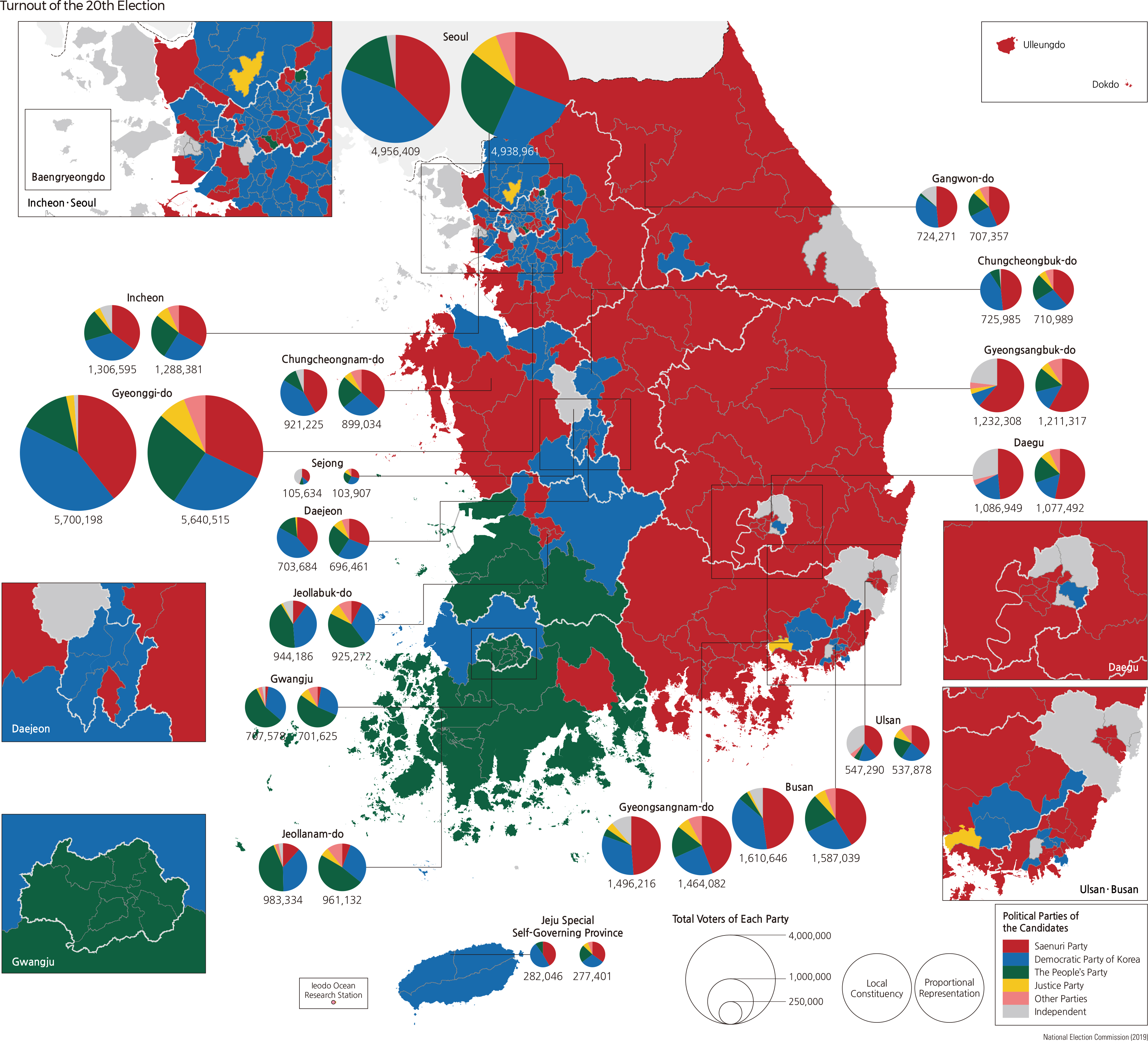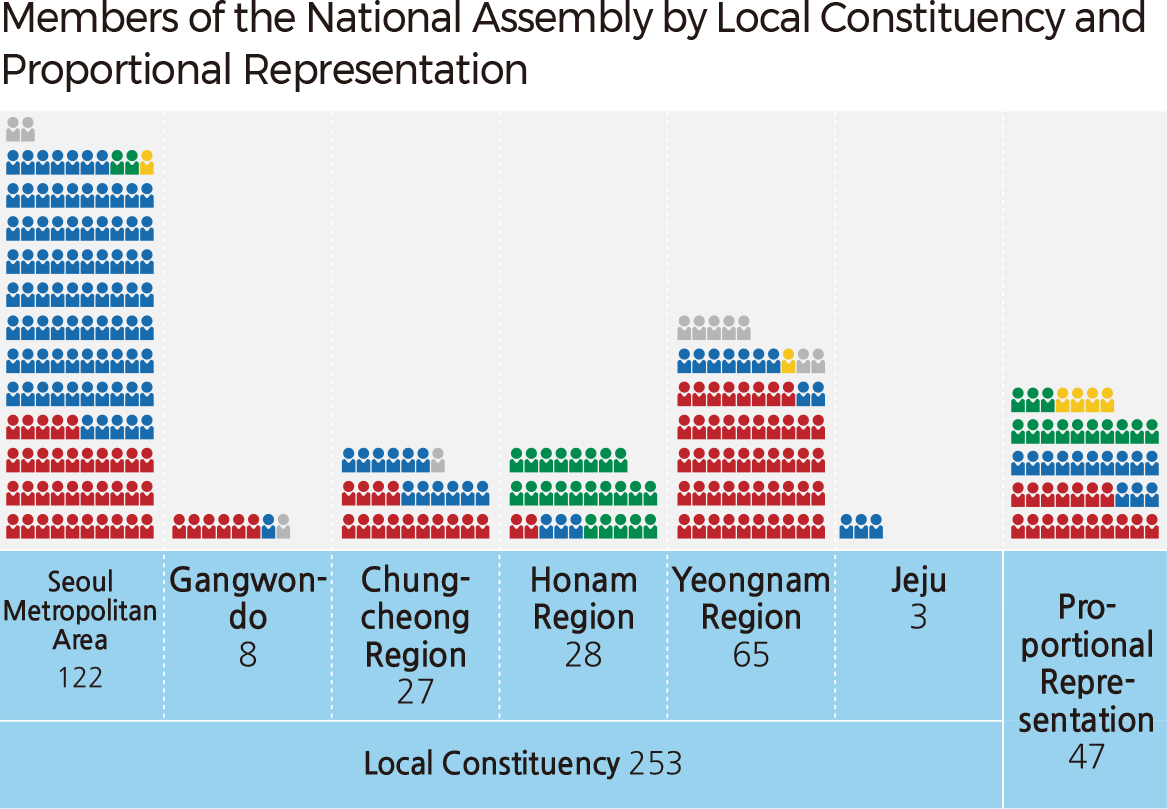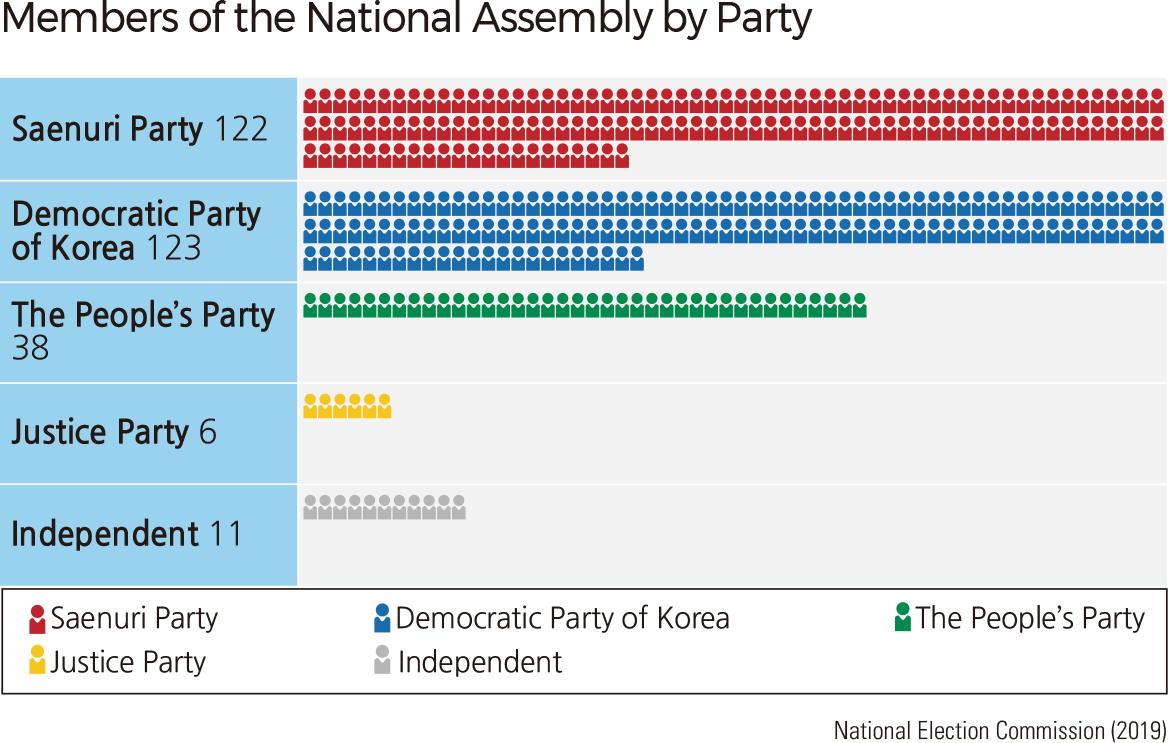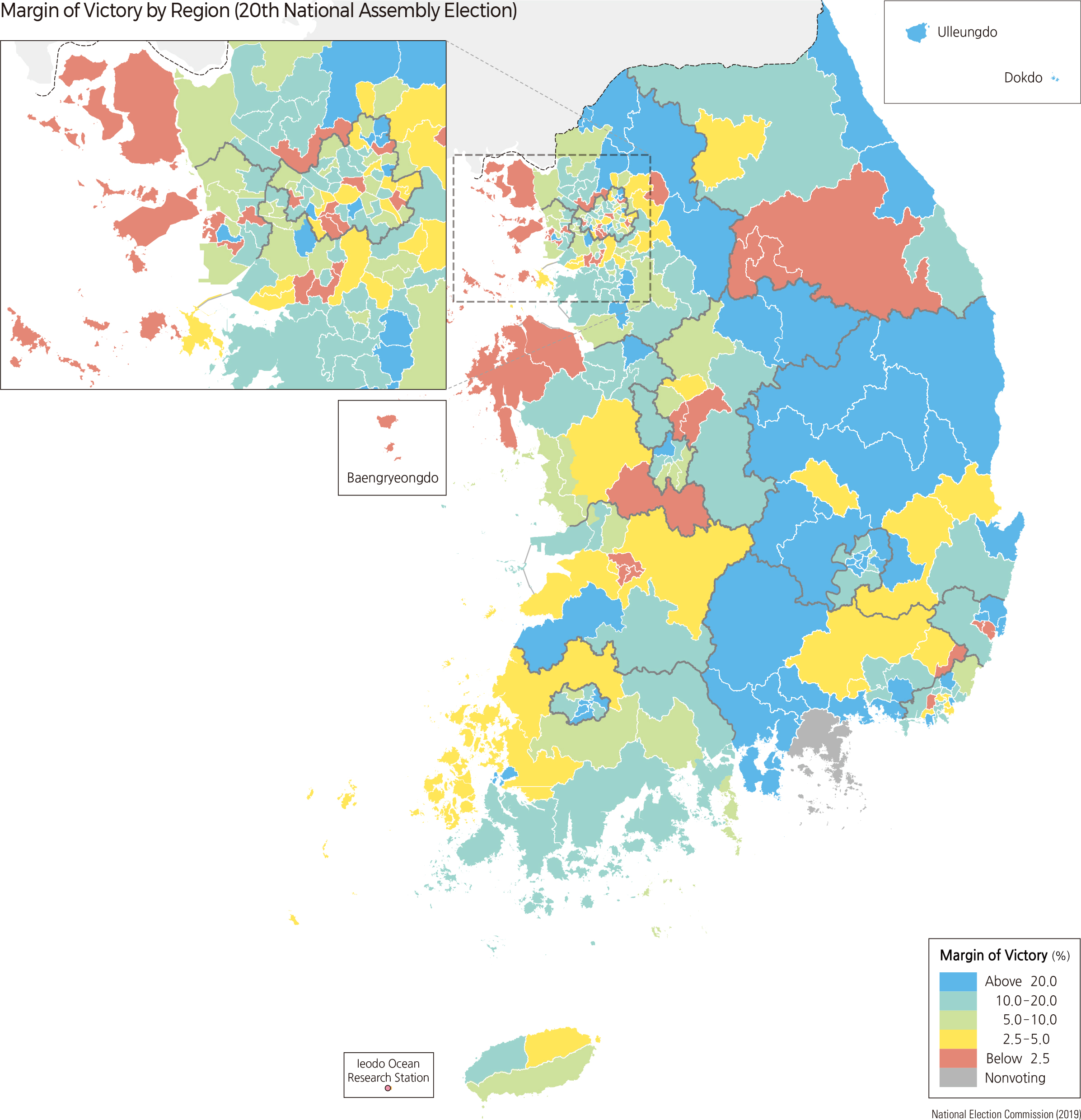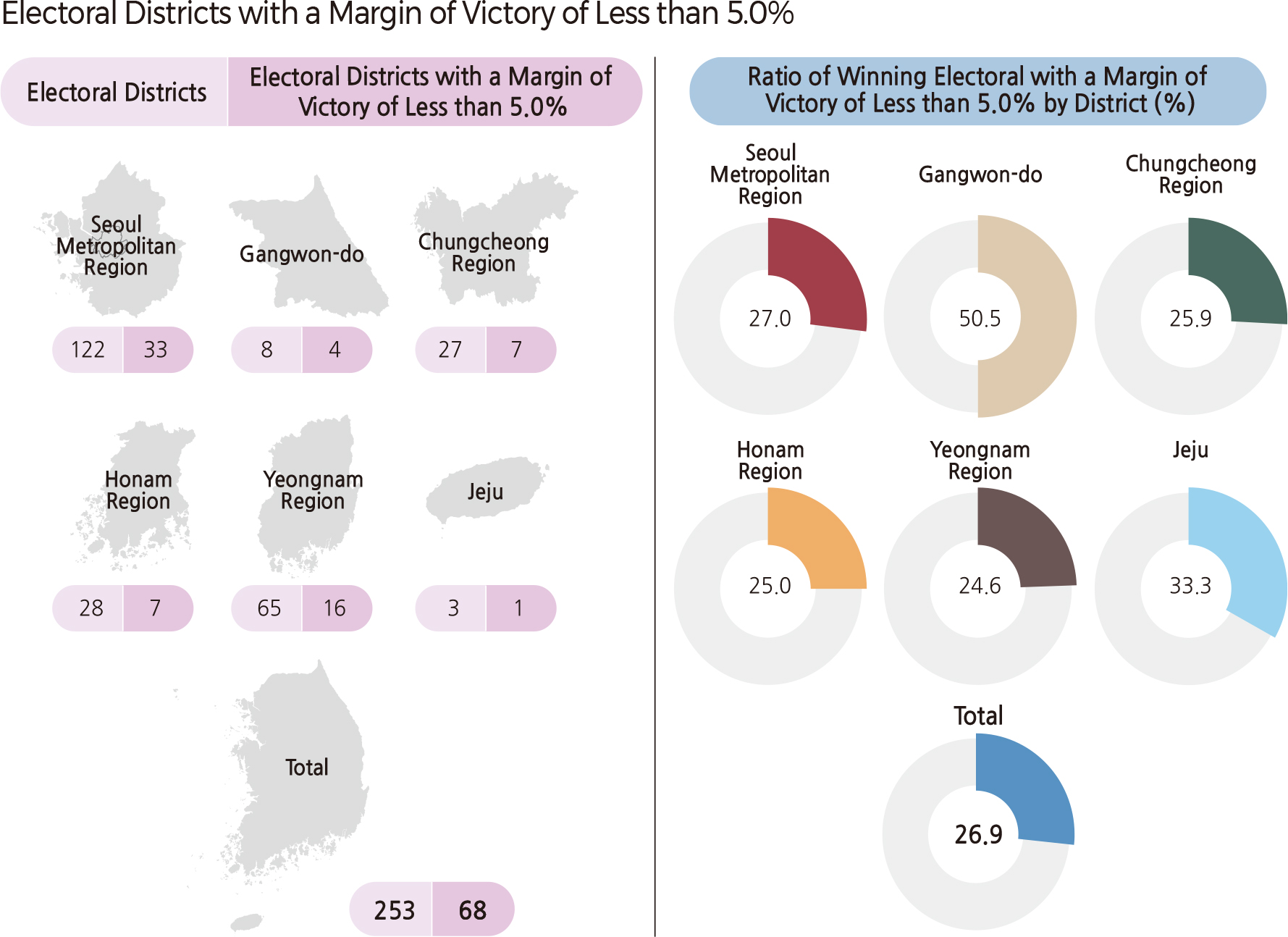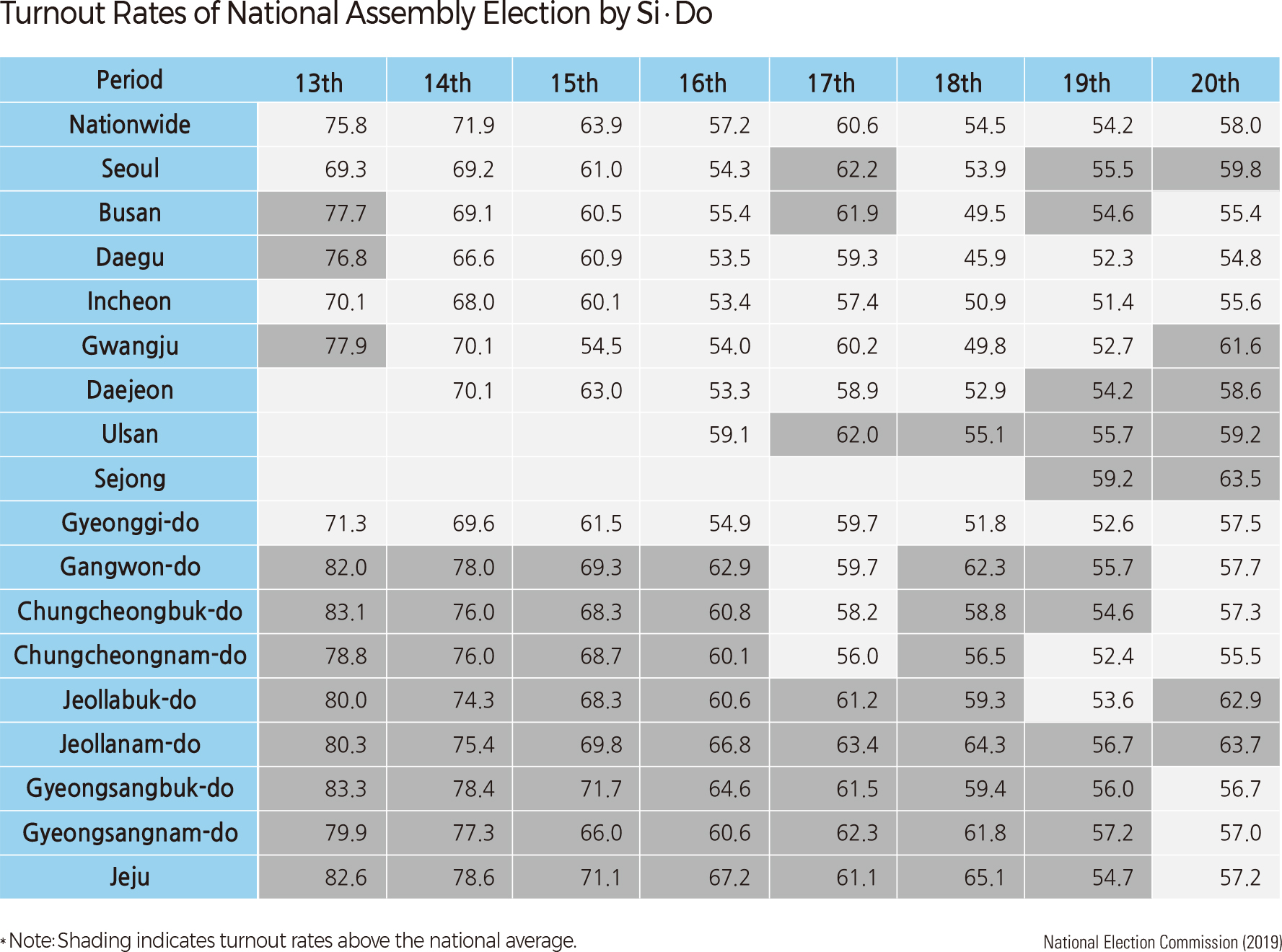English I 2019
The legislators who make up the legislative body are elected through electoral district elections that adopt a first-past-the-post electoral system, and proportional representative elections, in which divisions in an electorate are determined in proportion to the number of votes each political party earned. The 20th National Assembly election was held on April 13, 2016, and elected 300 members; 253 members were elected through the electoral district elections and 47 members were elected through the proportional representative elections.
The voter turnout rate for the 20th National Assembly election was 58.0%, up 3.8% from the 54.2% for the 19th National Assembly election. Geographically, Jeollanam-do had the highest voter turnout rate at 63.7%, and Daegu had the lowest turnout at 54.8%. This election was the first National Assembly election in which early voting was introduced. The voter turnout rate for early voting in this election was 12.2%.
Results from the election showed that the ruling Saenuri Party won 122 seats (105 electoral district seats and 17 proportional representative seats). Of the opposition parties, the Democratic Party of Korea won 123 seats (110 electoral district seats and 13 proportional representative seats), the People's Party won 38 seats (25 electoral district seats and 13 proportional representative seats), the Justice Party won 6 seats (2 electoral district seats and 4 proportional representative seats), and the No Political Party Affiliation occupied 11 electoral district seats. As a result, the 20th National Assembly was launched with fewer ruling party seats than opposition seats for the first time in 16 years. The Saenuri Party became the second party only after suffering a crushing defeat in the Seoul Metropolitan Area but also by being defeated in its traditional strongholds. It was the first time for the ruling first party to become the second party in the National Assembly Election. The Democratic Party of Korea became the first party by producing winners in the ruling party's strongholds and the Seoul Metropolitan Area. The People's Party became the third party by dominating the Honam region and by ranking second in the party-list proportional representation vote. For the first time in 20 years since the 15th National Assembly election in 1996, the third party became one of the negotiating groups (parties with no less than 20 seats). There were also changes in the regional structure of the election results, with nine opposition party candidates elected in the ruling party’s strongholds in the Yeongnam region and two ruling party candidates elected in the opposition parties’ strongholds in the Honam region.
Of the 300 elected candidates of the 20th National Assembly, there were 51 women elected, representing 17.0% of the total elected; women won 10.3% of electoral district seats (26 out of 253 seats) and 53.2% of proportional representative seats (25 out of 47 seats). Since proportional representatives are elected sequentially from the candidates in the prior ranking, more women can be elected if they are placed in an odd-numbered rank. Until the 20th National Assembly Election, each party has placed female candidates in odd-numbered ranks to promote women's entry into the National Assembly. Starting with the 21st National Assembly Election, this regulation has been in effect.
According to the election results of the 20th National Assembly, electoral districts whose winners had a narrow margin of victory over the second-place candidates appeared nationwide because progressive candidates were competitive in the Yeongnam region, the traditional stronghold of the conservative party. Two progressive parties, the Democratic Party of Korea and the People’s Party, were compatible in the traditionally progressive strongholds in the Honam region, and the races were close for each party in the Seoul Metropolitan Area and Chungcheong region. Sixty-eight districts, about 27% of the total electoral districts showed less than a 5 percent difference between the percent of the vote earned by the first- and second-place candidates. In 31 electoral districts, the winning candidate's margin of victory was less than 2.5%. The smallest difference in the number of votes between the first- and second-place candidates was 26. In one electoral district, one candidate ran alone and was elected without a vote.
Since the 20th National Assembly Election, there has been a change in the names and number of political parties and their members. In January 2017, some members defecting from the Saenuri Party founded the Bareun Party. In February 2017, the Saenuri Party changed its name to the Liberty Korea Party. In February 2018, the Bareun Party and the People's Party merged to form the Bareunmirae Party and succeeded the proportional representative of the People's Party. In February 2018, members of the People's Party, who opposed the merger of the People's Party and the Bareun Party, created the Party for Democracy and Peace. The Our Republican Party and the Minjung Party were also founded in August 2017 and October 2017, respectively. Meanwhile, the number of non-partisan members increased significantly in August 2019 due to the departure of members of the Party for Democracy and Peace. Of the 253 members elected through electoral district elections, 18 lost their positions. As of October 2019, 15 electoral districts have elected new members of the National Assembly through re-elections and by-elections.
Article 41, paragraph 2 of the Constitution of the Republic of Korea stipulates that “The number of members of the National Assembly shall be determined by Act, but the number shall not be less than 200.” As the spatial distribution of the population has changed, the spatial extent of the electoral district has been modified, and the numbers of electoral district seats and proportional representatives have also changed. The population gap between the most populated electoral district and the least populated electoral district is another important factor in determining an electoral district system. By the Constitutional Court's ruling, the population gap was adjusted to be within 4 : 1 in December 1995. The gap was set to 3 : 1 in October 2001, and the gap was further changed to 2 : 1 in October 2014. On March 2, 2016, the National Assembly established the lower population limit of an electoral district at 140,000 and the upper population limit at 280,000, based on the number of residents at the end of October 2015, and passed the Amendment to the Public Official Election Act that increased the number of electoral seats from 247 to 253 by adding six more seats. As a result, two electoral districts, which consisted of five cities and counties, were newly formed in Gangwon-do: the Hongcheon-gun/Cheorwon-gun/Hwacheon-gun/Yanggu-gun/Inje-gun electoral district and the Taebaek-si/Hoengseong-gun/Yeongwol-gun/Pyeongchang-gun/Jeongseon-gun electoral district.
The type of elections, political issues, and the political party's campaigning often influence the voter turnout. Voter turnouts have gradually declined over time. By region, the turnouts in the provinces have traditionally been higher than those of the national average. However, with the introduction of an early voting system and an increase in the turnout among people in their 20s and 30s, the regional turnouts have changed since the 2000s. In the 20th National Assembly Election, the turnout of the provinces, except Jeollanam-do and Jeollabuk-do, was lower than that of the national average. |
